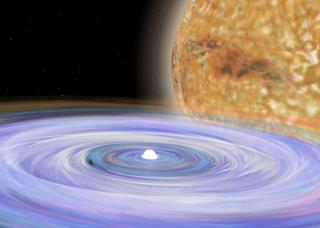Bibcode
Aviles, A.; Zharikov, S.; Tovmassian, G.; Michel, R.; Tapia, M.; Roth, M.; Neustroev, V.; Zurita, C.; Andreev, M.; Sergeev, A.; Pavlenko, E.; Tsymbal, V.; Anupama, G. C.; Kamath, U. S.; Sahu, D. K.
Referencia bibliográfica
The Astrophysical Journal, Volume 711, Issue 1, pp. 389-398 (2010).
Fecha de publicación:
3
2010
Revista
Número de citas
36
Número de citas referidas
30
Descripción
We present infrared JHK photometry of the cataclysmic variable (CV) SDSS
J123813.73 - 033933.0 and analyze it along with optical spectroscopy,
demonstrating that the binary system is most probably comprised of a
massive white dwarf with T eff = 12000 ± 1000 K and a
brown dwarf of spectral type L4. The inferred system parameters suggest
that this system may have evolved beyond the orbital period minimum and
is a bounce-back system. SDSS J123813.73 - 033933.0 stands out among CVs
by exhibiting the cyclical variability that Zharikov et al. called
brightenings. These are not related to specific orbital phases of the
binary system and are fainter than dwarf novae outbursts that usually
occur on longer timescales. This phenomenon has not been observed
extensively and, thus, is poorly understood. The new time-resolved,
multi-longitude photometric observations of SDSS J123813.73 - 033933.0
allowed us to observe two consecutive brightenings and to determine
their recurrence time. The period analysis of all observed brightenings
during 2007 suggests a typical timescale that is close to a period of
~9.3 hr. However, the brightenings modulation is not strictly periodic,
possibly maintaining coherence only on timescales of several weeks. The
characteristic variability with double orbital frequency that clearly
shows up during brightenings is also analyzed. The Doppler mapping of
the system shows the permanent presence of a spiral arm pattern in the
accretion disk. A simple model is presented to demonstrate that spiral
arms in the velocity map appear at the location and phase corresponding
to the 2:1 resonance radius and constitute themselves as double-humped
light curves. The long-term and short-term variability of this CV is
discussed together with the spiral arm structure of an accretion disk in
the context of observational effects taking place in bounce-back
systems.
Proyectos relacionados

Estrellas Binarias
El estudio de las estrellas binarias es una parte esencial de la astrofísica estelar. Una gran parte de las estrellas de nuestra Galaxia y de otras galaxias se ha formado en sistemas binarios o múltiples, por lo que entender la estructura y evolución de estos sistemas es importante desde el punto de vista estelar y galáctico. Un aspecto en el que
Pablo
Rodríguez Gil